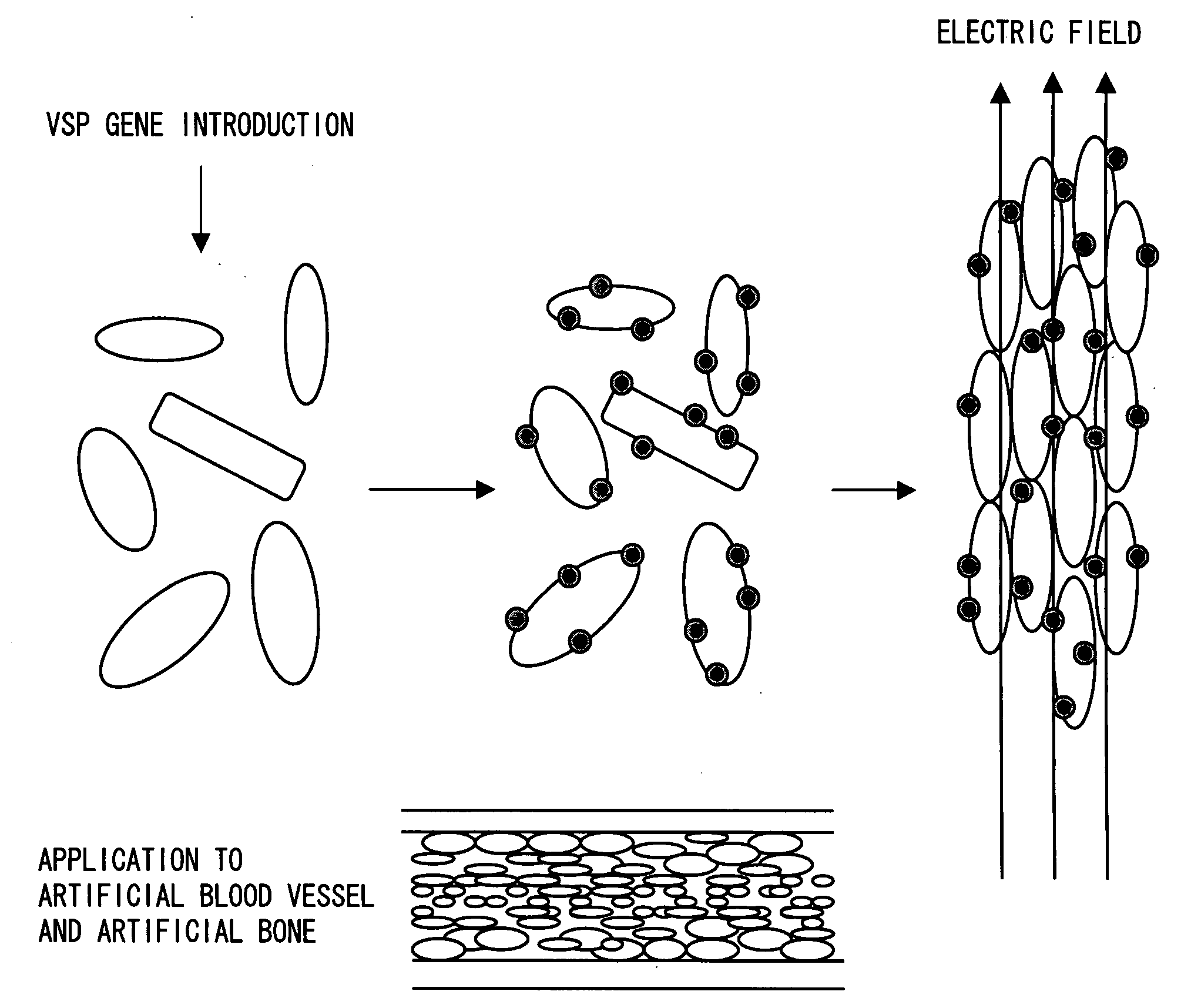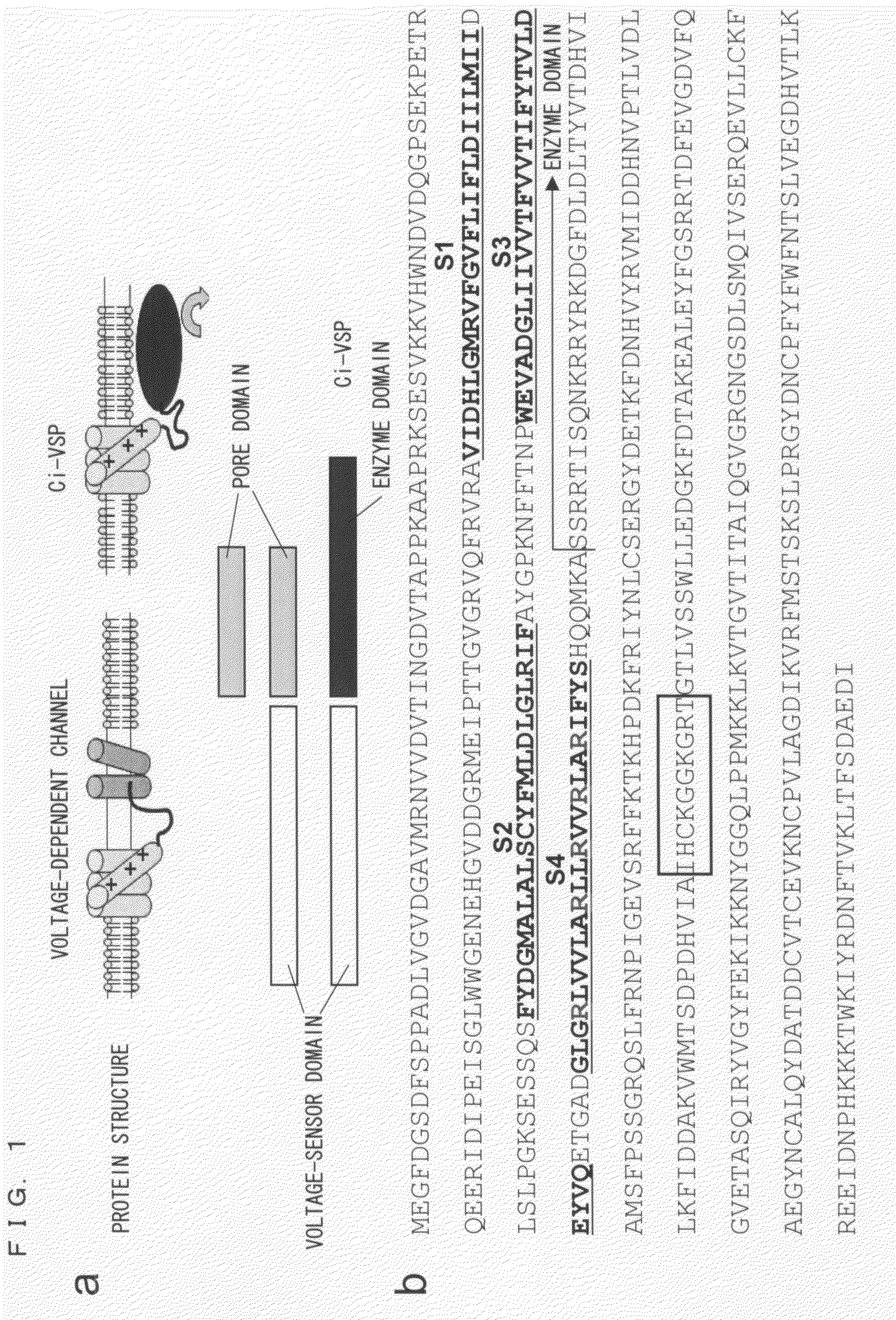Novel Ion Channel-Like Polypeptide and Use Thereof
a polypeptide and ion channel technology, applied in the field of single polypeptides, can solve the problems of difficult application of electrophysiological techniques, difficult to obtain information concerning local membranes using these techniques, and inability to analyze materials of a small structure, etc., to achieve control of sperm motility, avoid pregnancy, and treat or prevent infertility
- Summary
- Abstract
- Description
- Claims
- Application Information
AI Technical Summary
Benefits of technology
Problems solved by technology
Method used
Image
Examples
examples
Experimental Procedures
[Preparation of Plasmid]
[0206]Reverse transcription PCR was performed using isolated total RNA of adult Ciona intestinalis as a template. PCR was run in 30 to 35 cycles consisting of 96° C. for 10 seconds, 60° C. for 5 seconds, and 72° C. for 2 minutes, using primers (5′-CGGGATCCGCCACCATGGAGGGATTCGACGGTTCAG-3′ (SEQ ID NO: 3); 5′-ATAGTTTAGCGGC CGCCTAAATGTCTTCAGCATCTG-3′ (S EQ ID NO: 4)).
[0207]The PCR products were inserted into BamHI / NotI sites of pBluescript vector (Stratagene) to subclone Ci-VSP cDNA. Point mutations or deletions were introduced to the cDNA using the QuickChange Site-Directed Mutagenesis available from Stratagene, and the introduction of a mutation was confirmed by determining the sequence.
[0208]For expression of Ci-VSP cDNA in Xenopus oocyte, pSD64TR and pSD64TF (kindly provided by Dr. T. Snutch) or pGEM HE vector (Promega) were used. cRNA was synthesized with an mMESSAGE mMACHINE kit (Ambion) according to the manufacturer's protocol.
[Electr...
example 2
Ci-VSP Transmembrane Domain functioning as Potential Sensor
[0219]The fact that the amino acid sequence of the putative transmembrane domain of Ci-VSP is highly similar to that of the potential sensor of the potential-dependent channel suggests the possibility that the Ci-VSP may be able to detect a change in membrane potential as does the potential-dependent channel. In order to access this, an important experiment was conducted that detected a potential-dependent movement of charge due to a transmembrane shift of the positively charged segment of the potential sensor.
[0220]FIG. 2a shows a representative example of asymmetrical displacement currents recorded from a cut-open oocyte of Xenopus laevis expressing Ci-VSP. A pulse was applied ranging from −80 to +160 mV in 10-mV steps. Linear and symmetrical currents were subtracted from a holding potential of −110 mV by a P / −8 procedure. FIG. 2b is a graph comparing carried charges at different membrane potentials, resulting from a chang...
example 3
Cytoplasmic Domain of Ci-VSP as Phosphoinositide Phosphatase
[0228]According to the procedure described in Example 1, assessment was made to show that the cytoplasmic domain of Ci-VSP polypeptide is phosphoinositide phosphatase (FIG. 3). FIG. 3a is a diagram comparing amino acid sequence of the phosphatase active center of Ci-VSP with that of PTEN in various species. The Ci-VSP polypeptide has the active center similar to that of known phosphatase.
[0229]As shown in FIG. 3a, the phosphatase-like domain of Ci-VSP is highly homologous to PTEN. PTEN has phosphatidylinositol which is dephosphorylated at the 3-site of its inositol ring.
[0230]To see whether the Ci-VSP has phosphatase activity that uses PI(3, 4, 5)P3 as a substrate, a fusion protein of GST and the whole C-terminal cytoplasmic region of Ci-VSP was synthesized. FIG. 3b represents phosphoinositide phosphatase activity of the fusion protein of glutathione s-transferase and the phosphatase-like domain of Ci-VSP by a malachite gre...
PUM
| Property | Measurement | Unit |
|---|---|---|
| depth | aaaaa | aaaaa |
| pH | aaaaa | aaaaa |
| pH | aaaaa | aaaaa |
Abstract
Description
Claims
Application Information
 Login to View More
Login to View More - R&D
- Intellectual Property
- Life Sciences
- Materials
- Tech Scout
- Unparalleled Data Quality
- Higher Quality Content
- 60% Fewer Hallucinations
Browse by: Latest US Patents, China's latest patents, Technical Efficacy Thesaurus, Application Domain, Technology Topic, Popular Technical Reports.
© 2025 PatSnap. All rights reserved.Legal|Privacy policy|Modern Slavery Act Transparency Statement|Sitemap|About US| Contact US: help@patsnap.com



